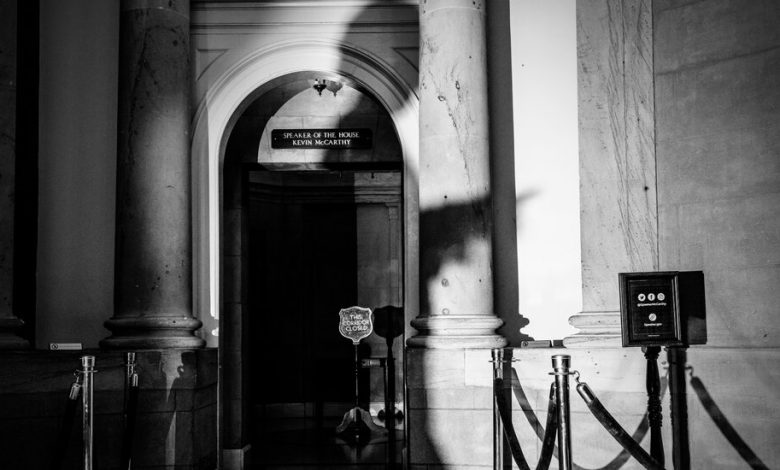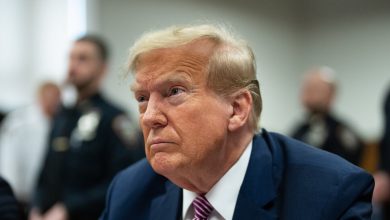The Deep Roots of Republican Dysfunction

The collapse of the House Republican majority into chaos is the clearest possible evidence that the party is off the rails.
Of course, the Republican Party has been off the rails for a while before now. This was true in 2010, when Tea Party extremists swept through the party’s ranks, defeating more moderate Republicans — and pretty much any other Republican with an interest in the actual work of government — and establishing a beachhead for radical obstructionism. It was true in 2012, when many Republican voters went wild for the likes of Michele Bachmann, Herman Cain and Newt Gingrich in the party’s presidential primary, before settling on the more conventionally presidential Mitt Romney. But even then, Romney reached out to Donald Trump — famous, politically speaking, for his “birther” crusade against President Barack Obama — for his blessing, yet another sign that the Republican Party was not on track.
The truth of the Republican Party’s deep dysfunction was obvious in 2013, when congressional Republicans shut down the government in a quixotic drive to repeal the Affordable Care Act, and it was obvious in 2016, when Republican voters nominated Trump for president. Everything that has followed, from the rise of influencer-extremist politicians like Representative Lauren Boebert to the party’s complicity in insurrectionist violence, has been a steady escalation from one transgression to another.
The Republican Party is so broken that, at this point, its congressional wing cannot function. The result is that this period is now the longest the House of Representatives has been in session without a speaker. And as Republican voters gear up to nominate Trump a third time for president, the rest of the party is not far behind. The only question to ask, and answer, is why.
One popular answer is Donald Trump who, in this view, is directly responsible for the downward spiral of dysfunction and deviancy that defines today’s Republican Party. It’s his success as a demagogue and showman that set the stage for the worst of the behavior we’ve seen from elected Republicans.
The problem, as I’ve already noted, is that most of what we identify as Republican dysfunction was already evident in the years before Trump came on the scene as a major figure in conservative politics. Even Trump’s contempt for the legitimacy of his political opponents, to the point of rejecting the outcome of a free and fair election, has clear antecedents in conservative agitation over so-called voter fraud, including efforts to raise barriers to voting for rival constituencies.
Another popular answer is that we’re seeing the fruits of polarization in American political life. And it is true that, within both parties, there’s been a marked and meaningful move away from the center and toward each side’s respective flank. But while the Democratic Party is, in many respects, more liberal than it has ever been, it’s also not nearly as ideologically uniform as the Republican Party. Nor does a rigid, doctrinaire liberalism serve as a litmus test among Democratic voters in Democratic Party primaries outside of a small handful of congressional districts.
Joe Biden, for example, is the paradigmatic moderate Democrat and, currently, the president of the United States and leader of the Democratic Party, with ample support across the party establishment. And in Congress, there’s no liberal equivalent to the House Freedom Caucus: no group of nihilistic, obstruction-minded left-wing lawmakers. When Democrats were in the majority, the Congressional Progressive Caucus was a reliable partner of President Biden’s and a constructive force in the making of legislation. If the issue is polarization, then it only seems to be driving one of our two parties toward the abyss.
Helpfully, the extent to which the Democratic Party still operates as a normal American political party can shed light on how and why the Republican Party doesn’t. Take the overall strength of Democratic moderates, who hold the levers of power within the national party. One important reason for this fact is the heterogeneity of the Democratic coalition. To piece together a majority in the Electoral College, or to gain control of the House or Senate, Democrats have to win or make inroads with a cross-section of the American public: young people, affluent suburbanites, Black, Hispanic and Asian Americans voters, as well as a sizable percentage of the white working class. To lose ground with any one of these groups is to risk defeat, whether it’s in the race for president or an off-year election for governor.
A broad coalition also means a broad set of interests and demands, some of which are in tension with each other. This has at least two major implications for the internal workings of the Democratic Party. First, it makes for a kind of brokerage politics in which the most powerful Democratic politicians are often those who can best appeal to and manage the various groups and interests that make up the Democratic coalition. And second, it gives the Democratic Party a certain amount of self-regulation. Move too far in the direction of one group or one interest, and you may lose support among the others.
If you take the internal dynamics of the Democratic Party and invert them, you get something like those within the Republican Party.
Consider the demographics of the Republican coalition. The majority of all voters in both parties are white Americans. But where the Democratic Party electorate was 61 percent white in the 2020 presidential election, the Republican one was 86 percent, according to the Pew Research Center. Similarly, there is much less religious diversity among Republicans — more than a third of Republicans voters in 2020 were white evangelical Protestants — than there is among Democrats. And while we tend to think of Democrats as entirely urban and suburban, the proportion of rural voters in the Democratic Party as a whole is actually greater than the proportion of urban voters in the Republican Party. There is, in other words, less geographic diversity among Republicans as well.
Most important, where nearly half of Democrats identify themselves as either “moderate” or “conservative” — compared with the half that call themselves “liberal” — nearly three-quarters of Republicans identify themselves as “conservative,” with just a handful of self-proclaimed moderates and a small smattering of liberals, according to Gallup. This wasn’t always true. In 1994, around 33 percent of Republicans called themselves “moderate” and 58 percent said they were “conservative.” There were even, at 8 percent, a few Republican liberals. Now the Republican Party is almost uniformly conservative. Moderate Democrats can still win national office or hold national leadership. Moderate Republicans cannot. Outside a handful of environments, found in largely Democratic states like Maryland and Massachusetts, moderate Republican politicians are virtually extinct.
But more than the number of conservatives is the character of the conservatism that dominates the Republican Party. It is, thanks to a set of social and political transformations dating back to the 1960s, a highly ideological and at times reactionary conservatism, with little tolerance for disagreement or dissent. The Democratic Party is a broad coalition geared toward a set of policies — aimed at either regulating or tempering the capitalist economy or promoting the inclusion of various groups in national life. The Republican Party exists almost entirely for the promotion of a distinct and doctrinaire ideology of hierarchy and anti-government retrenchment.
There have always been ideological movements within American political parties. The Republican Party was formed, in part, by adherents to one of the most important ideological movements of the 19th century — antislavery. But, as the historian Geoffrey Kabaservice has observed, “The conversion of one of America’s two major parties into an ideological vehicle” is a “phenomenon without precedent in American history.”
It is the absence of any other aim but the promotion of conservative ideology — by any means necessary, up to and including the destruction of democratic institutions and the imposition of minority rule — that makes this particular permutation of the Republican Party unique. It helps explain, in turn, the dysfunction of the last decade. If the goal is to promote conservative ideology, then what matters, for Republican politicians, is how well they adhere to and promote conservatism. The key issue for conservative voters and conservative media isn’t whether a Republican politician can pass legislation or manage a government or bridge political divides; the key question is whether a Republican politician is sufficiently committed to the ideology, whatever that means in the moment. And if conservatism means aggrieving your enemies, then the obvious choice for the nation’s highest office is the man who hates the most, regardless of what he believes.
The demographic homogeneity of the Republican Party means that there isn’t much internal pushback to this ideological crusade. Nothing to temper the instincts of politicians who would rather shut down the government then accept that a majority of Congress passed a law over their objections, or who would threaten the global economy to get spending cuts they could never win at the ballot box.
Worse, because the institutions of American democracy give a significant advantage to the current Republican coalition, there’s also no external force pushing Republican politicians away from their most rigid extremes. Just the opposite: There is a whole infrastructure of ideologically motivated money and media that works to push Republican voters and politicians further to the right.
It is not simply that the Republican Party has politicians like Jim Jordan and Matt Gaetz and Marjorie Taylor Greene. It’s that the Republican Party is practically engineered to produce politicians like Jim Jordan and Matt Gaetz and Marjorie Taylor Greene. And there’s no brake — no emergency off-switch — that might slow or stop the car. The one thing that might get the Republican Party back on the rails is a major and unanticipated shift in the structure of American politics that forces it to adapt to new voters, new constituencies and new conditions.
It’s hard to imagine what that might be. It can’t come soon enough.
The Times is committed to publishing a diversity of letters to the editor. We’d like to hear what you think about this or any of our articles. Here are some tips. And here’s our email: [email protected].
Follow The New York Times Opinion section on Facebook, Twitter (@NYTopinion) and Instagram.




